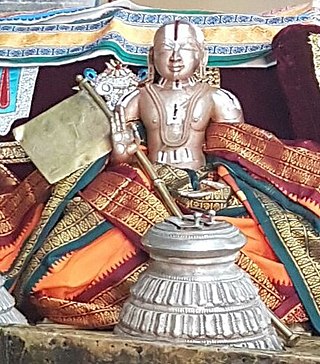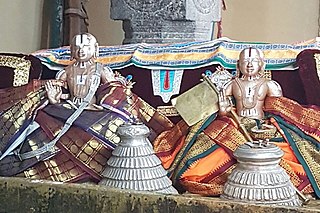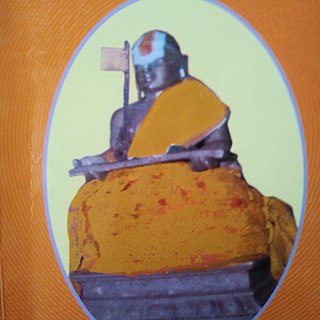Related Research Articles
Shudra or Shoodra is one of the four varnas of the Hindu caste system and social order in ancient India. Various sources translate it into English as a caste, or alternatively as a social class. Theoretically, class serving other three classes. The word caste comes from the Portuguese word casta.

Iyengars are an ethnoreligious community of Tamil-speaking Hindu Brahmins, whose members follow Sri Vaishnavism and the Visishtadvaita philosophy propounded by Ramanuja. Found mostly in the Southern Indian states of Tamil Nadu, Karnataka, and Andhra Pradesh, Iyengars are divided into two denominations, the Vadakalai and the Tenkalai. The community belongs to the Pancha Dravida Brahmana classification of Brahmins in India.

Ramanuja, also known as Ramanujacharya, was an Indian Hindu philosopher, guru and a social reformer. He is noted to be one of the most important exponents of the Sri Vaishnavism tradition within Hinduism. His philosophical foundations for devotionalism were influential to the Bhakti movement.

Nammalvar was one of the twelve Alvar saints of Tamil Nadu, India, who are known for their affiliation to the Vaishnava tradition of Hinduism. The verses of the Alvars are compiled as the Naalayira Divya Prabandham, where praises are sung of 108 temples that are classified as divine realms, called the Divya Desams. Nammalvar is considered to be the fifth in the line of the twelve Alvar. He is highly regarded as a great mystic of the Vaishnava tradition. He is also considered to be the foremost among the twelve Alvars, and his contributions amount to 1352 among the 4000 stanzas in the Naalayira Divya Prabandam.

The Alvars were the Tamil poet-saints of South India who espoused bhakti (devotion) to the Hindu preserver deity Vishnu, in their songs of longing, ecstasy, and service. They are venerated in Vaishnavism, which regards Vishnu as the Ultimate Reality.

The Naalayira Divya Prabandham is a collection of 4,000 Tamil verses composed by the 12 Alvars. It was compiled in its present form by Nathamuni during the 9th–10th centuries. The work, an important liturgical compilation of the Tamil Alvars, marks the beginning of the canonisation of 12 Vaishnava poet saints, and these hymns are still sung extensively today. The works were lost before they were collected and organised in the form of an anthology by Nathamuni.

Vedanta Desikan (1268–1369), also rendered Vedanta Desikar, Swami Vedanta Desikan, and Thoopul Nigamaantha Desikan, was an Indian polymath who wrote philosophical as well as religious and poetical works in several languages, including Sanskrit, Manipravaḷam, Tamil and Prakrit. He was an Indian philosopher, Sri Vaishnava guru, and one of the most brilliant stalwarts of Sri Vaishnavism in the post-Ramanuja period. He was a Hindu devotee, poet, Master of Acharyas (desikan) and a logician and mathematician. He was the disciple of Kidambi Appullar, also known as Athreya Ramanujachariar, who himself was of a master-disciple lineage that began with Ramanuja. Vedanta Desikan is considered to be avatar (incarnation) of the divine bell of Venkateshvara of Tirumala by the Vadakalai sect of Sri Vaishnavism. Vedanta Desikan belongs to Vishwamitra/Kaushika gotra.

Pancharatra was a religious movement in Hinduism that originated in late 3rd-century BCE around the ideas of Narayana and the various avatars of Vishnu as their central deities. The movement later merged with the ancient Bhagavata tradition and contributed to the development of Vaishnavism. The Pancharatra movement created numerous literary treatises in Sanskrit called the Pancharatra Samhitas, and these have been influential Agamic texts within the theistic Vaishnava movements.

Alagiya Manavalan, best known by his epithet Manavala Mamunigallit. 'The great saint, Manavalan' (1370–1450), was a Hindu theologian. He was a major proponent of the Sri Vaishnavism tradition in the 15th century in Tamilakam, disseminating it with the help of his eight disciples. The disciples of Manavalan established places of learning to teach the Vishishtadvaita philosophy in Tamilakam.
The Sri Bhasya is the most famous work of the Hindu philosopher Ramanuja (1017–1137). It is his commentary on Badarayana's Vedanta/Brahma Sutra.

Sri Vaishnavism, or the Sri Vaishnava Sampradaya, is a denomination within the Vaishnavism tradition of Hinduism. The name refers to goddess Lakshmi, as well as a prefix that means "sacred, revered", and the god Vishnu, who are together revered in this tradition.

Yamunacharya, also known as Alavandar and Yamunaithuraivan, was a Vishistadvaita philosopher based in Srirangam, Tamil Nadu, India. He is best-known for being a preceptor of Ramanuja, one of the leaders of the Sri Vaishnava tradition. He was born in the early 10th century CE, and was the grandson of Nathamuni, a famed yogi, who collected the works of the Tamil Alvars.
Tiruppan Alvar was one of the twelve Alvars of South India, who were poet-saints known for their affiliation to the Sri Vaishnava tradition of Hinduism. The verses of the Alvars are compiled as the Naalayira Divya Prabandham and the 108 temples revered in the text are classified as Divya Desams. Tiruppan Alvar is considered the eleventh in the line of the twelve Alvars.

Nathamuni, also known as Sri Ranganathamuni,, was a Vaishnava theologian who collected and compiled the Naalayira Divya Prabandham.

Vishnu, also known as Narayana and Hari, is one of the principal deities of Hinduism. He is the supreme being within Vaishnavism, one of the major traditions within contemporary Hinduism.

Chinna Jeeyar, more formally known as Sri Tridandi Srimannarayana Ramanuja Chinna Jeeyar Swami, is an Indian religious guru and yogi ascetic known for his spiritual discourses on Sri Vaishnavism. He subscribes to Thenkalai tradition of Sri Vaishnavism. He operates spiritual centers in the US. He is the designer and planner of the Statue of Equality, a statue dedicated to Ramanujacharya, in Hyderabad, India. He is also guiding Telangana State Government in the renovation of Yadadri Temple. He is one of the few Jiyars who accept non-brahmin disciples.
Satani is a Vaishnavite community who render temple services in the states of Andhra Pradesh, Karnataka, Tamil Nadu and Telangana in India. Traditionally, they have rendered a variety of services as supervisors and purohits of minor temples, guardians of temple properties, heralds, singers and torch-bearers at festivals, bodyguards of Jiyars, and providers of umbrellas, flower garlands, and namam clay. They have claimed Brahmin status, although this has been contested by Brahmins as they do not wear the sacred thread.

Lakshmi Kumara Tatacharya, (1571–1643) was a prominent saint and guru of the Sri Vaishnava tradition of Hinduism. He was the preceptor of Vedanta Desika. He served as the rajaguru for a ruler of the Vijayanagara Empire, Venkatapati Raya. He was also the overseer of a number of sacred temples known as the Divya Desams, including Srirangam, Kanchipuram, Tirumala, Melkote, and Srivilliputtur.
Parasara Bhattar, also called Periya Bhattar and Parashara Bhattarya, was a follower of Ramanuja, a 12th-century Sri Vaishnava teacher. He was the son of Koorathalvar. His works include the Srirangarajastavam. He wrote a commentary in Sanskrit on Vishnu Sahasranamam from a Sri Vaishnava viewpoint, titled Bhagavadguna Dharpanam, in contrast to the Advaita view of Adi Shankara.

Ayee Jananyacharya or Devaraja Perumal was a Hindu Sri Vaishnava religious leader, great saint, and one of the important propagator of the Sri Vaishnavism tradition. Sri Jananyacharya Swami was Seventh in the lineage of Sri Ramanujacharya. He was a scholar in ubhaya vedanta who took Vishishtadvaita school of vedanta to the next level and widely popularized and propagated the Sri Vaishnava tradition.
References
- ↑ Francis Clooney (2013). His Hiding Place Is Darkness: A Hindu-Catholic Theopoetics of Divine Absence. Stanford University Press. p. 32. ISBN 9780804788809.
- 1 2 Nancy Ann Nayar (1996). "The "other Āṇṭāḷ : portrait of a 12th century Srīvaiṣṇava woman". In Steven Rosen (ed.). Vaiṣṇavī: women and the worship of Krishna. Motilal Banarsidass. pp. 231–232. ISBN 9788120814370.
- 1 2 3 4 5 V. Rangachari (1917). "The Successors of Ramanuja and the Growth of Sectarianism among the Sri-Vaiahnavas". The Journal of the Bombay Branch of the Royal Asiatic Society. XXIV: 112–117.
- 1 2 C. Panduranga Bhatta, ed. (1997). Contribution of Karaṇāṭaka to Sanskrit. Institute of Asian Studies. p. 329.
- 1 2 Amaresh Datta, ed. (1987). Encyclopaedia of Indian Literature. Vol. 5: Sasay to Zorgot. Sahitya Akademi. ISBN 8126012218.
- 1 2 Surendranath Dasgupta (2000) [1975]. A History of Indian Philosophy. Vol. III (First Indian ed.). Motilal Banarsidass. ISBN 9788120804142.
- ↑ S. M. Srinivasa Chari (2018). Vaisnavism: Its Philosophy, Theology and Religious Discipline. Motilal Banarsidass. p. 160. ISBN 9788120841352.
- 1 2 3 Francis X. Clooney; Tony K. Stewart (2004). Sushil Mittal; Gene Thursby (eds.). The Hindu World. Routledge. pp. 170–171. ISBN 978-1-134-60875-1.
- ↑ Katherine K. Young (2002). "Om, the Vedas, and the Status of Women with Special Reference to Śrīvaiṣṇavism". In Laurie Patton (ed.). Jewels of Authority: Women and Textual Tradition in Hindu India. Oxford University Press. pp. 106–107. ISBN 9780195350647.